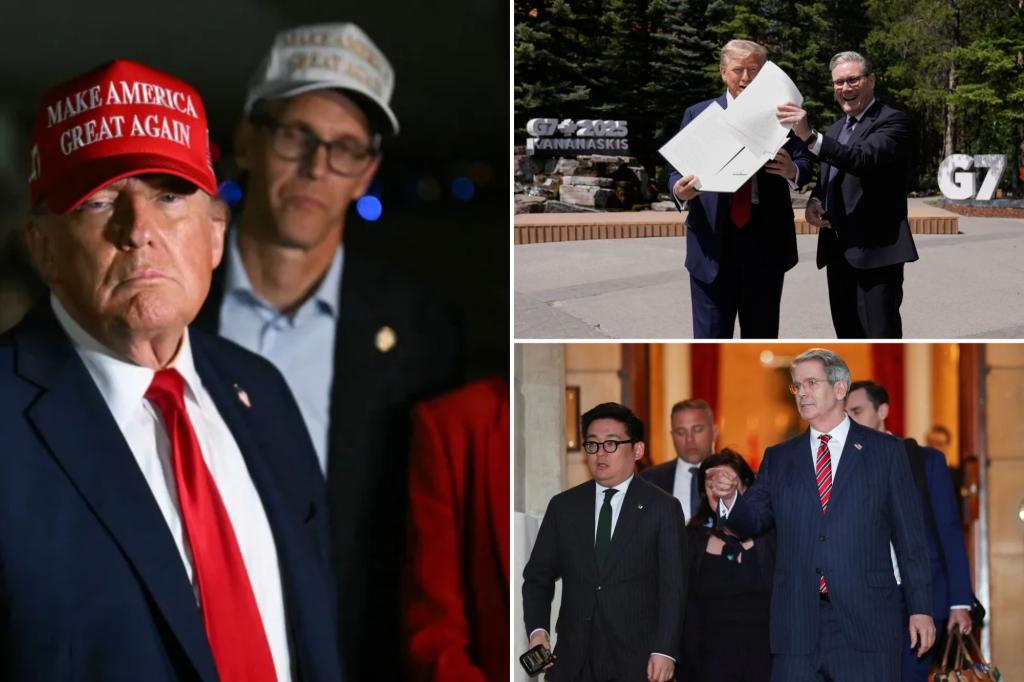WASHINGTON – President Trump said he’ll begin rolling out “reciprocal” tariffs Friday on countries that have yet to reach a tentative deal with his team — with the new US trade taxes hitting as high as “60 or 70%.
“We’re going to start sending letters out to various countries starting [Friday]. We’ll probably have 10 or 12 go out,” Trump told reporters after midnight as he returned from a speech at the Iowa State Fairgrounds.
“I think by the 9th [of July] they’ll be fully covered, and they will range in value from maybe 60 or 70% tariffs to 10 and 20% tariffs.”
The upper rates indicate Trump may boost some nations’ figures even higher than described in his April 2 “Liberation Day” rollout, which established a new 10% baseline tariff — roughly triple prior rates — and high duties on countries with large trade imbalances with the US.
The highest previously announced “reciprocal” rates — pegged to a nation’s trade deficit with the US — were 49% for clothing- and shoes-manufacturing hub Cambodia, 48% for next-door Laos and 47% for the world’s top vanilla exporter, Madagascar.
“We’ve done the final form, and it’s basically going to explain what the countries are going to be paying in tariffs,” Trump told reporters early Friday.
“It’s a lot of money for the country, but we’re giving them a bargain. … I don’t want to stretch it too much, we want to keep it pretty reasonable.”
Trump said he expected to send up to a dozen letters to countries each day until the Wednesday deadline that he set for negotiations.
“As we get to the smaller countries, we’re pretty much going to keep the tariffs the same,” he said.
“They’ll start to pay on Aug. 1. The money will start to come into the United States on Aug. 1 in pretty much all cases.”
It’s unclear which countries will face tariffs in the range of 60-70%, but the renewed tough trade talk comes as positive economic indicators buoy Trump’s domestic standing — with job growth exceeding expectations again in June, inflation remaining near the Federal Reserve’s 2% target (2.4% in May) and major stock market indices notching record highs this past week.
Critics of Trump’s trade offensive have expressed concern about a significant pass-through effect on the price of consumer goods sourced abroad.
Trump already has brokered tentative trade deals with China, the UK and Vietnam, as well as a “roadmap” with India, and has scored trade significant concessions from Israel and Taiwan, but most of the countries walloped by the pending levies have yet to reach a deal, including major partners such as Japan and the European Union.
Trump has spoken pessimistically about talks with Tokyo, which faces a 24% tariff, and the EU risks a 50% rate, which Trump revised upward from an initial 20% in protest of a pending digital tax on major US internet firms.
The three already-announced deals in principle only partially walk back the new tariffs.
The pending UK trade agreement would keep in effect Trump’s new 10% baseline on most goods but would exempt the majority of British-made cars, steel and aluminum from higher 25% rates separately announced by Trump. London reportedly agreed to open its market to US meat and ethanol in return.
The Chinese trade agreement walked back tit-for-tat tariff rates while a more comprehensive deal could be worked out. Trump said that Beijing also agreed to open its markets to US goods.
The Vietnam deal will spare America’s seventh-largest importer from a new 46% tariff, but the rate will be a still-substantial 20%, and 40% on goods transiting from other countries such as China.
Most Canadian and Mexican goods are governed by the USMCA pact and therefore aren’t directly impacted by the trade war, though Trump slapped 25% tariffs in March on items not part of that framework to pressure the nations to halt the flow of illicit fentanyl and illegal immigration.
Trump’s statement that smaller countries will see similar rates comes after his administration focused on brokering deals with the top 15 US trading partners, despite the significant economic contribution of smaller nations, particularly in Asia, that produce cheaply made goods due to lower labor costs.
The president said May 26 that his tariffs — broadly designed to make US industry more competitive by taxing the foreign products or forcing other nations to lower their trade barriers — weren’t intended to re-shore low-skill work such as garment manufacturing.
In addition to China, India and Vietnam, places such as Bangladesh (facing a 37% potential tariff), Sri Lanka (44%), Pakistan (29%) and Indonesia (32%) are top producers of clothes and shoes.
“We’re not looking to make sneakers and t-shirts. We want to make military equipment. We want to make big things. We want to make, do the AI thing,” Trump said.
“I’m not looking to make t-shirts, to be honest. I’m not looking to make socks. We can do that very well in other locations. We are looking to do chips and computers and lots of other things and tanks and ships,” he said.
Read the full article here


